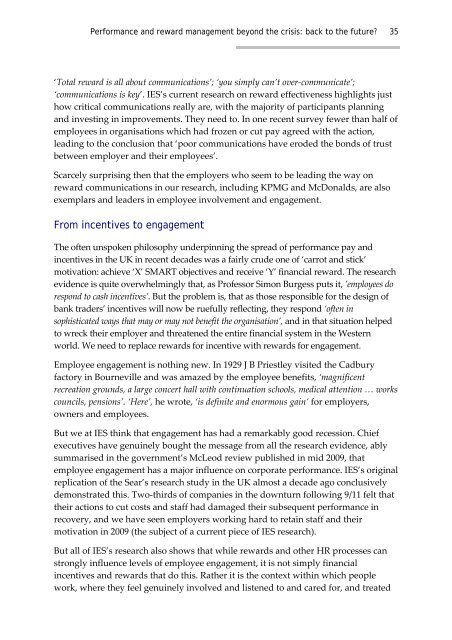PDF of this item - The Institute for Employment Studies
PDF of this item - The Institute for Employment Studies
PDF of this item - The Institute for Employment Studies
- No tags were found...
You also want an ePaper? Increase the reach of your titles
YUMPU automatically turns print PDFs into web optimized ePapers that Google loves.
Per<strong>for</strong>mance and reward management beyond the crisis: back to the future? 35‘Total reward is all about communications’; ‘you simply can’t over‐communicate’;‘communications is key’. IES’s current research on reward effectiveness highlights justhow critical communications really are, with the majority <strong>of</strong> participants planningand investing in improvements. <strong>The</strong>y need to. In one recent survey fewer than half <strong>of</strong>employees in organisations which had frozen or cut pay agreed with the action,leading to the conclusion that ‘poor communications have eroded the bonds <strong>of</strong> trustbetween employer and their employees’.Scarcely surprising then that the employers who seem to be leading the way onreward communications in our research, including KPMG and McDonalds, are alsoexemplars and leaders in employee involvement and engagement.From incentives to engagement<strong>The</strong> <strong>of</strong>ten unspoken philosophy underpinning the spread <strong>of</strong> per<strong>for</strong>mance pay andincentives in the UK in recent decades was a fairly crude one <strong>of</strong> ‘carrot and stick’motivation: achieve ‘X’ SMART objectives and receive ‘Y’ financial reward. <strong>The</strong> researchevidence is quite overwhelmingly that, as Pr<strong>of</strong>essor Simon Burgess puts it, ’employees dorespond to cash incentives’. But the problem is, that as those responsible <strong>for</strong> the design <strong>of</strong>bank traders’ incentives will now be ruefully reflecting, they respond ‘<strong>of</strong>ten insophisticated ways that may or may not benefit the organisation’, and in that situation helpedto wreck their employer and threatened the entire financial system in the Westernworld. We need to replace rewards <strong>for</strong> incentive with rewards <strong>for</strong> engagement.Employee engagement is nothing new. In 1929 J B Priestley visited the Cadburyfactory in Bourneville and was amazed by the employee benefits, ‘magnificentrecreation grounds, a large concert hall with continuation schools, medical attention … workscouncils, pensions’. ‘Here’, he wrote, ‘is definite and enormous gain’ <strong>for</strong> employers,owners and employees.But we at IES think that engagement has had a remarkably good recession. Chiefexecutives have genuinely bought the message from all the research evidence, ablysummarised in the government’s McLeod review published in mid 2009, thatemployee engagement has a major influence on corporate per<strong>for</strong>mance. IES’s originalreplication <strong>of</strong> the Sear’s research study in the UK almost a decade ago conclusivelydemonstrated <strong>this</strong>. Two‐thirds <strong>of</strong> companies in the downturn following 9/11 felt thattheir actions to cut costs and staff had damaged their subsequent per<strong>for</strong>mance inrecovery, and we have seen employers working hard to retain staff and theirmotivation in 2009 (the subject <strong>of</strong> a current piece <strong>of</strong> IES research).But all <strong>of</strong> IES’s research also shows that while rewards and other HR processes canstrongly influence levels <strong>of</strong> employee engagement, it is not simply financialincentives and rewards that do <strong>this</strong>. Rather it is the context within which peoplework, where they feel genuinely involved and listened to and cared <strong>for</strong>, and treated
















